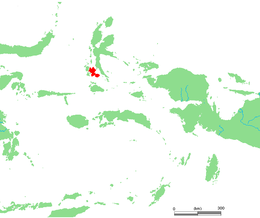Bacan
 |
|
| Geography | |
|---|---|
| Location | South East Asia |
| Coordinates | 0°37′S 127°31′E / 0.617°S 127.517°E |
| Archipelago | Moluccas (Maluku Islands) |
| Area | 1,899.8 km2 (733.5 sq mi) |
| Highest elevation | 2,120 m (6,960 ft) |
| Highest point | Buku Sibela |
| Administration | |
| Demographics | |
| Population | 60,741 (2010 Census) |
The Bacan Islands, formerly also known as the Bachans, Bachians, and Batchians, are an group of islands in the Moluccas in Indonesia. They are mountainous and forested, lying south of Ternate and southwest of Halmahera. The islands are administered by the South Halmahera Regency of North Maluku Province.
Bacan (Dutch: Batjan), formerly also known as Bachian or Batchian, is the group's largest island. The second and third largest islands are Kasiruta and Mandioli. Bacan includes about 60,000 people of which about 8,000 live in the capital Labuha; it is subdivided into 7 districts. Kasiruta and Mandioli each have over 8,000 inhabitants, and each is subdivided into 2 districts. There are dozens of smaller islands in the group.
In 1513, the first Portuguese trading fleet to reach the Moluccas set up a trading post on Bacan which at the time was subservient to the Sultan of Ternate. The fleet's commander, Captain Antonio de Miranda Azevedo, left seven men on Bacan to buy cloves for the following year's expedition. Their arrogant behaviour and reported bad treatment of Bacan women led to their murder. As Ternate did not have enough stock, the ship for which the men had stayed to prepare was used by the Sultan of Ternate to fill Ferdinand Magellan's last ship, which was the first ship to circumnavigate the world. A slave and two birds of paradise were given to the ship by Bacan. Bacan became a place of refuge for rebellious Ternateans. The Portuguese sent a punitive expedition against Bacan but it failed, and instead the Portuguese Governor Galvão challenged Bacan's sultan to a duel to determine who was to be subservient to whom. The challenge was accepted but the duel never took place.
In 1557, Father Antonio Vaz converted Bacan's sultan and court members to Catholicism. The king subsequently married Sultan Hairun of Ternate who had also become a Catholic. Ternate invaded in 1578 and the king apostasized. A community of Christians remained and were later joined by correligionists from Tobelo and Ambon. A small Roman Catholic hospital was built by an elderly Dutch nun. Today, Protestants significantly outnumber Catholics. During the mid-19th century Moluccan travels of British naturalist Alfred Russel Wallace, Christians in the Moluccas were called Orang Sirani (lit. "Nazarene People"), a term regularly applied to locals of European ancestry in the Malay Archipelago, thought to have been descended from the Portuguese. They had dressed in white and black and Wallace reports they dance "quadrilles, waltzes, polkas, and mazurkas with great vigour and much skill".
...
Wikipedia

